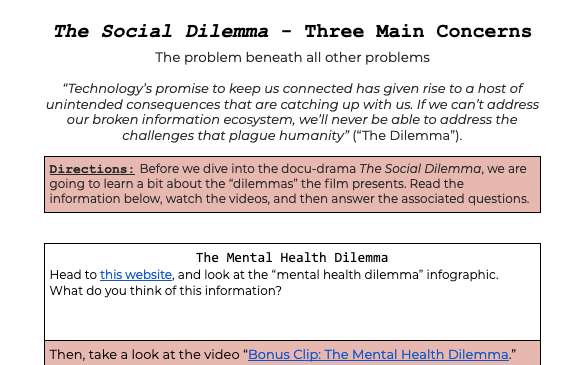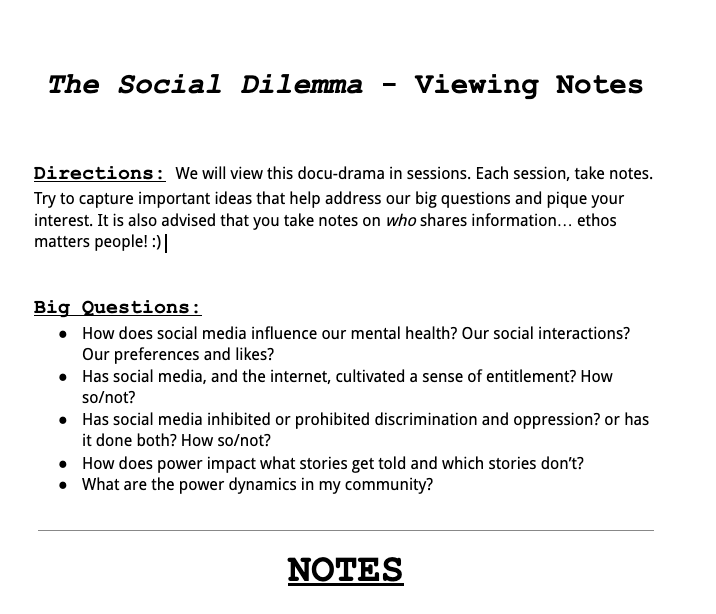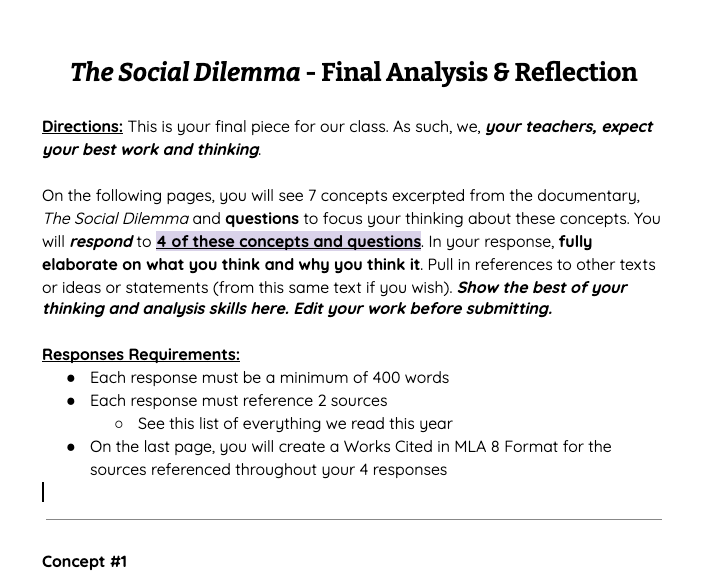In this blog post, I’m sharing my end of the year plans: social media lesson plans. With these plans, my students engaged in conversations and critical thinking about social media.

This year, with all that students went through, my grade level team and I wanted to end the school year with a concept that genuinely intrigued students. A topic in which they felt invested. We discussed that it would be interesting to continue with our planned theme, and find a way to incorporate a documentary of some kind–movies always hook students more than a book or article, especially seniors in May.
Our themes for the semester were planned out: Convergence of Self and Place, Untold Stories of America/ns, and Power, Entitlement and Oppression. With this last theme, we didn’t want to go the typical route of race, gender, because many of our students already had a course where these were the focus, and they were tired of these being the topics. Now, I understand some may think, “They don’t get to be tired! These are important topics! They need to talk about them.”
I agree, but they are hearing, seeing, and talking about them. These issues have been in the news and on social media for the past year(s) nonstop. Rather than force these topics on them and overwhelm them emotionally, given the past few months of emotional warfare (quarantine, no “real” senior year, no prom, no assemblies or rallies, the news, political climate… the list goes on), we want to look at Power, Entitlement, and Oppression through a new lens. A lens that could allow them to talk about other topics (such as race and gender) if they so choose. And, a lens they were already invested in.
With all this in mind, I knew what we needed to watch. Netflix’s The Social Dilemma.
Why did we need to watch this?
- The film is about social networks and media… and they’re teenagers
- It mixes drama and documentary for maximum entertainment and education value
- It brings up topics such as race, mental health, threats to democracy, and other issues that impact students daily
- The ideas challenge their thinking about their relationship with social networks in a non-threatening way (defensive teenagers = no learning)
- It addresses our topic perfectly in a way students had not previously encounter
I’m sure there are more reasons, but those were my main motivations. After thinking about how we could create social media lesson plans that addressed our theme and involved this docu-drama in a creative and constructive way, I talked with my grade level team. Their immediate “Yeses!” about the movie sealed our path.
With all the technical parts sorted (permission slips, how to view it, copyright concerns, etc), I set to create the social media lesson plans–the “pre-reading” activities through the ultimate assessment.
Generally, as best practice necessitates, I start with the end goal. At this point, I knew students needed to think about our theme critically and apply these concepts to their own lives. Further, I knew I wanted them to do this through a new lens: social networks.
From there, I considered their final assessment, which would be the final assessment of the school year. They had already done a few projects, a handful of essays, and a plethora of discussions. What did they still need to demonstrate? Their ability to respond to a specific idea and make connections from its core idea to other concepts. In other words, they needed to synthesize.
Rather than a formal essay, we decided students would respond to a few of the key statements made throughout the documentary and apply its “gist,” as one of my colleagues called it, to other texts and concepts they’d read and encountered throughout the semester.
Social Media Lesson Plans, Stage 1 – The Hook
With these goals solidified, I turned to considering how to use these social media lesson plans to bring them into the documentary so they were open minded and interested.
Thankfully, The Social Dilemma has a great website where they offer further information and “bonus” material. In looking through the extra content, I knew this was the place to start. I created a graphic organizer that linked in the three bonus videos and provided questions for students to answer. In these videos, experts discuss three main concerns social networks presents: mental health, democracy, and discrimination.
The videos provided by The Social Dilemma website are short, roughly 2-3 minutes, and provide students with an idea of how the documentary will function. Also, these videos present intriguing ideas about fundamental problems that technology presents, problems students hadn’t necessarily considered.
On this graphic organizer, underneath the link to each video, students answered a few questions about the concepts presented. We did this activity together, so after they answered the questions, we held a class conversation which was fruitful. Students were excited to watch the film! Check out the graphic organizer here.

Social Media Lesson Plans, Stage 2 – Background Context
Before diving into the film, there was another consideration I wanted to present to students: the power of big tech. Recent events with the tech industry made it easy to show the relevancy of this documentary. In 2019, big tech faced off with Congress about antitrust concerns. Clearly, the world was waking up to problems with the growth and monopolization of these companies, and this was an interesting dilemma in itself for my students to consider.
For this inquiry activity, I found a video that defines antitrust and which provides a brief history of the United States’ viewpoint and enforcement of antitrust laws. From there, I gave students four options for a reading about the Congressional hearing in 2019 about antitrust — I found articles from CNBC, NPR, and The Atlantic, and the fourth option was for students to find their own article.
Although none of my students elected to find their own article, I wanted to provide this as an option because of the ideas the documentary would bring up. Mainly, the idea that we need to search out our own news sources and read from multiple sides about an issue. Some of my students don’t care, but others definitively voice opinions about how “right wing” or “left wing” media skews “facts.” Thus, they could find their own news source.
While my students learned about antitrust and found the Congressional hearing informative, I definitely think I could have done more with this concept. In hindsight, I wish I circled back to this after we watched the documentary better, but… it didn’t happen.
My students engaged readily in the antitrust conversation. Plus, we even talked about other industries where monopolies were a problem: food, pharmaceuticals, and television. My colleague even found an infographic that showed the umbrella food companies that own most of the chains out there. (For copyright reasons, look this up yourself–it’s fascinating!)
If you want to see the activity I used for Big Tech vs. Congress, check it out here.

Social Media Lesson Plans, Stage 3 – Viewing
During the viewing process, I wanted students to take notes that would help them with the final assessment. Without putting too much effort or stress on myself or my students–I wanted them to enjoy the film, too–I created a document for taking notes.
We watched the film in two sessions, and each session they needed to take notes. From there, they could take any notes they wanted, in addition to taking notes related to our “big questions” (aka essential questions).
These questions related to our theme: Power, Entitlement, and Oppression. A few of the questions related to previous themes throughout the semester, to already help them think about “connections” (which was a key process in the final assessment).
Check out my note-taking document here.

Social Media Lesson Plans, Stage 4 – Final Assessment
Lastly, the summative assessment, which I previously discussed. After watching and discussing the documentary, my students’ final assessment was to respond to 4 different statements from the film and connect the key concepts within the statement to other sources we’d read throughout the semester.
We provided students with a list of all the sources we’d read together and reminded them of sources they perhaps chose to read. This was the easiest way to remind them of all we read, and the texts they could look back through.
One of my colleagues had a great idea, and I wish I had done this before my students started working on the assessment. He created a table and listed all the sources we’d read. From there, he modeled how to consider the “themes” or “gists” or each text. For example, these themes could be constructing identity, untold stories, rules of the land, power dynamics, and more. Lastly, he modeled how to tie The Social Dilemma statements on the assessment to these ideas. What were the “themes” or “gists” of the statements? How do these align with the themes of the texts we’ve already read?
Even though nearly all of my students formed connections on their own without this process, this brainstorming with students would have made their writing and synthesis even stronger.
I really liked this assessment, and it’s pretty adaptable. You can narrow down the options from which students choose. Or, you could have them choose more or less concepts to respond to. Perhaps you ask students to choose one idea to which they respond and write a whole essay instead of multiple shorter responses.

If you haven’t yet watched The Social Dilemma, I highly recommend it. It definitely achieved the goals I set. Really, it hooked students, informed their thinking, and challenged them.
Also, and equally important, it was the best way to end the year with them. They were not stressed to come to class. Most excitingly, they wanted to discuss and they didn’t complain about the final assessment. Yes… they didn’t complain about essentially writing an essay at the end of the year! This was a shock, especially with seniors.
If you use any of the social media lesson plans I’ve shared, please let me know! I’d love to hear how it worked for you. Or, if you’ve done something different with this documentary, please share!
As always, happy teaching. 🙂
 Backward Design: The Theory & In Practice
Backward Design: The Theory & In Practice Song Battle Project: Teaching Songs with Rhetorical Analysis
Song Battle Project: Teaching Songs with Rhetorical Analysis Crafting Effective Lesson Plans
Crafting Effective Lesson Plans